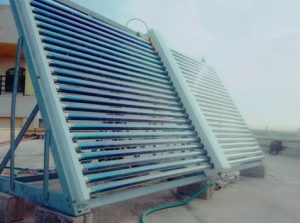Extracting fresh water from laundry water requires a great deal of energy, both thermal and mechanical. Renewable energy driven desalination is becoming more viable despite its expensive infrastructure because it utilizes free natural energy sources and releases harmless effluents to the environment. Solar radiation is usually chosen over other renewable energy sources because its thermal energy can be directly applied to drive desalination systems without the inevitable energy loss associated with energy conversion according to the second law of thermodynamics. Solar desalination systems are classified into direct and indirect processes depending on the energy path to fresh water. Direct solar desalination systems combine solar energy collection and desalination in one process producing fresh water distillate by directly applying collected solar energy to laundry water. Solar distillation using a solar still is an example of direct solar desalination. Indirect solar desalination systems comprise two sub-systems: a solar collection system and a desalination system. The solar collection sub-system is used either to collect heat using solar collectors and supply it via a heat exchanger to a thermal desalination process. The design of a practical system depends on the solar energy to extract distilled water suitable for drinking by solar energy using pipes of the air vacuum, which works to absorb the rays of the sun and converted to heat distilled 3.5 liters per hour.
| Economic | The cost of the project not to exceed 300 JOD. |
| Environmental | No types of chemicals should be used in the process |
| Social | – |
| Political | – |
| Ethical and Safety | Produced water should be handeled with care. Gloves should be worn when dealing with hot water. |
| Manufacturability and Sustainability | System should depend entirely on the radiation from the sun in water production. |
| Other | – |
Produced water should not contain more than 80 PPM of impurities according to the Jordanian Water department.
